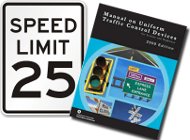Article from: www.thenewspaper.com/news/37/3737.asp
3/12/2012
Ohio: Bad Speed Limit Sign Invalidates Speeding Ticket
Ohio Court of Appeals affirms requirement that speed limit signs meet federal standards.
 Ohio's second highest court earlier this month exonerated a motorist who challenged his speeding ticket on the grounds the local jurisdiction violated federal laws regarding speed limit signs. On March 11, 2011, Oakwood Village Police Officer Edward Thyret, Jr was running a radar speed trap on Forbes Road. Thyret pulled over Jay Blum at 6:44pm, accusing him of driving 41 MPH in a 25 MPH zone.
Ohio's second highest court earlier this month exonerated a motorist who challenged his speeding ticket on the grounds the local jurisdiction violated federal laws regarding speed limit signs. On March 11, 2011, Oakwood Village Police Officer Edward Thyret, Jr was running a radar speed trap on Forbes Road. Thyret pulled over Jay Blum at 6:44pm, accusing him of driving 41 MPH in a 25 MPH zone.
At trial, Blum argued on his own behalf that the speed limit sign was too low to the ground, in violation of the Manual on Uniform Traffic Control Devices (MUTCD) standard that such signs in pedestrian areas be at least seven feet from the ground to ensure visibility. Blum cited the federal regulation as adopted by Ohio.
"Signs installed at the side of the road in rural districts shall be at least 1.5 m (5 ft), measured from the bottom of the sign to the near edge of the pavement," MUTCD Section 2A.18 states. "Where parking or pedestrian movements occur, the clearance to the bottom of the sign shall be at least 2.1 m (7 ft)."
Though Officer Thyret testified there were people walking in the area at the time of the stop, the Bedford Municipal Court dismissed Blum's contention that the standard applied and imposed a $150 fine. The three-judge appellate panel found the lower court judge to be in error.
"The record established that pedestrian traffic existed in the area; consequently, the clearance of the bottom of the sign was required to be seven feet from the ground," Judge Patricia Ann Blackmon wrote for the majority. "Based on this evidence, the trial court erred by concluding that Blum failed to establish that there was pedestrian traffic in the area of the sign."
The Federal Highway Administration maintains the MUTCD, and it is binding on all states. An Ohio law further mandates that the state's version of the manual applies to all roads open to the public.
"When a community's posted sign fails to comply with the uniform manual regarding signage requirements, the posted speed limit on the sign is unenforceable," Judge Blackmon wrote. "The police officer who conducted the traffic stop testified that Blum told him that he thought the speed limit was 35 MPH; consequently, we can conclude that he did not see the sign. It was the village's burden to offer rebuttal evidence that the sign was properly placed or nonetheless legible."
The court overturned Blum's convictions and ordered a refund of the costs for his appeal. A copy of the decision is available in a 60k PDF at the source link below.
Source: Oakwood Village v. Blum (Court of Appeals, State of Ohio, 3/1/2012)
Permanent Link for this item
Return to Front Page
 Ohio's second highest court earlier this month exonerated a motorist who challenged his speeding ticket on the grounds the local jurisdiction violated federal laws regarding speed limit signs. On March 11, 2011, Oakwood Village Police Officer Edward Thyret, Jr was running a radar speed trap on Forbes Road. Thyret pulled over Jay Blum at 6:44pm, accusing him of driving 41 MPH in a 25 MPH zone.
Ohio's second highest court earlier this month exonerated a motorist who challenged his speeding ticket on the grounds the local jurisdiction violated federal laws regarding speed limit signs. On March 11, 2011, Oakwood Village Police Officer Edward Thyret, Jr was running a radar speed trap on Forbes Road. Thyret pulled over Jay Blum at 6:44pm, accusing him of driving 41 MPH in a 25 MPH zone.